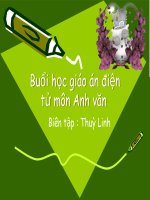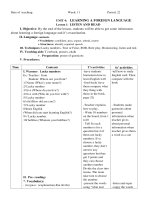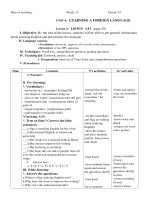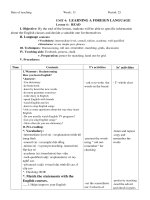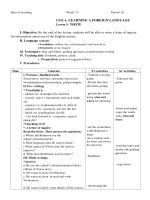unit 4 - used to
Bạn đang xem bản rút gọn của tài liệu. Xem và tải ngay bản đầy đủ của tài liệu tại đây (72.75 KB, 6 trang )
Supervisor: Dinh Tran Hanh Nguyen
Student: Huynh Thi Thu Thuy
Class: CQBT 05
Lesson Plan
Unit 4: SPECIAL EDUCATION
(textbook 10)
I. Description of class:
English level: intermediate – grade 10
Number of students: 44
Characteristics: active, intelligent and attentive
Teaching period: Language focus – grammar practice ( mechanical practices and meaningful
practice)
used to + infinitive
Duration: 10 minutes
II. Recent work:
Students have finished reading, speaking, listening and writing parts in unit 4.
Students have learnt simple past tense.
III. Objectives:
At the end of this practise part, students should be able to:
• Language:
• Understand the form and the use of the grammar point – “used to + bare infinitive”
• Use “used to” to express past habbits or things that do not happen any more.
• Skills: listening and speaking
IV. Approach and teaching aids:
• Communicative approach
• Teaching aids: blackboard, chart, wallchart.
V. Anticipated problems:
• Students may not remember the form or the use of “used to”.
• Students may not understand the rule of the game in task 2.
VI. Solutions:
• T reviews quickly the form and the use of “used to”
• T explains slowly as well as gives examples for Ss to understand.
VII. Procedures:
T greets Ss and check the class’ attendance.
Time T’s activities and Ss’ activities Contents
1’ T writes the lesson T is going to teach
on the board.
T asks Ss to recall the form and the
use of “used to”
T: We have just learnt the grammar point
“used to”, who can tell me the form of it?
Ss: used to + infinitive
T writes the form of “used to” on the
board.
Saturday, October 3
rd
, 2009
Unit 4: Special education
Grammar – used to
Practice
used to + infinitive
T: What is it used for?
Ss: It is used to talk about past things that do
not happen any more.
T: That’s right. We use “used to” when
talking about past habbits or things that do not
happen any more.
T: In order to help you practise this grammar
point, I’ve prepared some tasks for you. Now,
let’s do task 1
7’
I. Mechanical practice:
Task 1: repetition (2’)
T sticks a wallchart with some
sentences on it on the board.
T uses back-chaining technique to
conduct repetition chorally and
individually.
Task 2: picture prombts (5’)
In task 2, in order to make Ss
contribute to the task actively and
eagerly, T designs task 2 into a game
named TYPHOON
T sticks a wallchart with uncomplete
sentences and another one with
numbers from 1 to 6 on the board.
Task 1:
1. Liz used to have a
motorbike but last year she
sold it and bought a car.
2. What did you use to do
when you was five?
3. They didn’t use to like Tom
but they quite like him now.
Task 2:
0. I rarely eat ice-cream now,
but I ……
1. John lives in a big house
now, but he ……………
T divides class into 2 teams.
T explains the rule of the game:
T: you’re going to play a game called
TYPHOON. In the game, two teams have to
complete these sentences with the pictures I’ll
give you.
If one answer is correct, you are able to open
one among these 6 numbers.
Under these numbers there are 3
circumstances:
+ : your team will get more points (eg: +7)
-: your team will lose your points
: your team will lose all of your points
2. I go to work by car, but I
………
3. Nick and Jane hate each
other, but they …………..
4. Dennis gave up smoking 2
years ago. He ………..
5. They live in NewYork
now, but they ……………
6. She is a famous actress, but
she……..
1 2 3
4 5 6
Team A will begin the game first.
T considers the result and decides the
winner.
Answer:
0. I rarely eat ice-cream now,
but I used to love it when I
was young.
1. John lives in a big house
now, but he used to live in a
very small house.
2. I go to work by car, but I
used to go to work by
bicycle.
3. Nick and Jane hate each
other, but they used to be
best friends.
4. Dennis gave up smoking 2
years ago. He used to smoke
a lot.
5. They live in NewYork now,
but they used to live in
Hanoi.
6. She is a famous actress, but
she used to be a waitress.
2’
II. Meaningful practice:
Task 3: Guessing game
(technique: T gives a situation which implies
the structure and Ss decide what to say.)
T uses a folded three-flap paper with a
picture of a monk at the first flap.
T asks Ss how the monk used to
behave before he became a monk.
T: What are the 3 things the monk used to do




